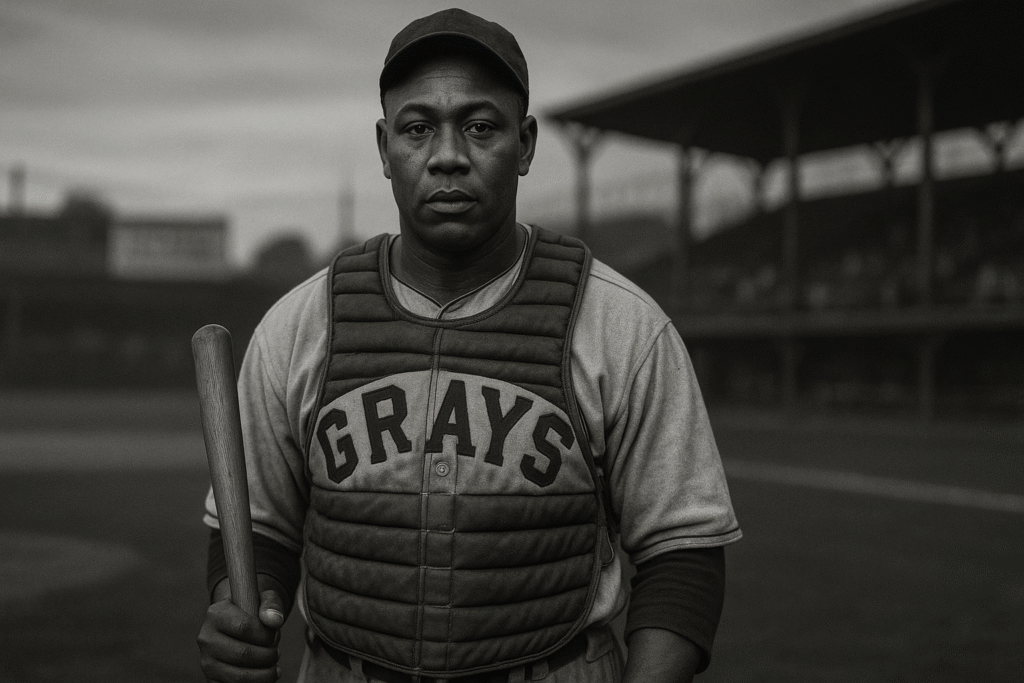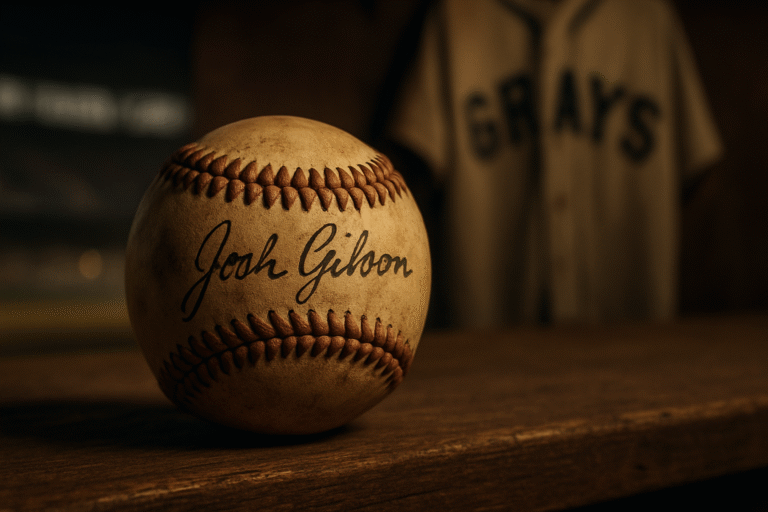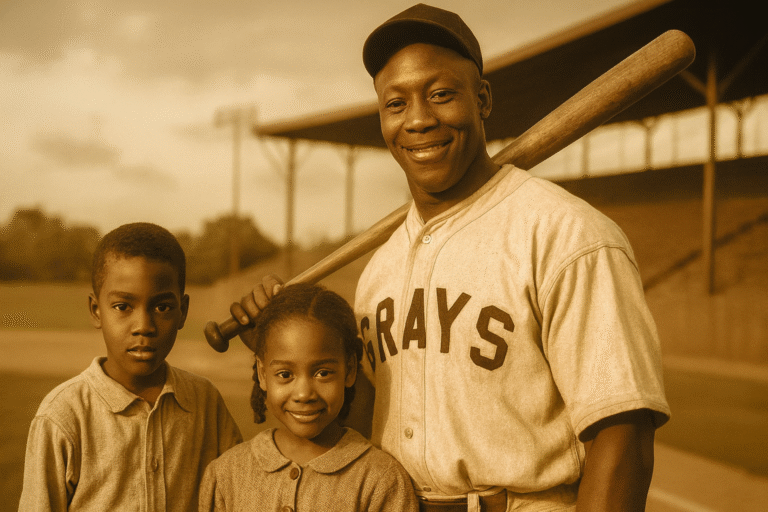
Josh Gibson’s Final Years: Legacy, Loss, and Lasting Power
He hit the ball harder than anyone of his era. He played through pain that most people never saw. In January 1947, at just 35, Josh Gibson died from a stroke. His passing came a few months before Jackie Robinson reached Major League Baseball. The timing still stings.
This story looks at his health decline, the toll of addiction and stress, and the weight of family responsibilities. It also shows how he kept producing for the Homestead Grays. It ends with the legacy that grew after he was gone, through his family, major honors, and the broader recognition of Negro Leagues achievements.
It is a hard story. It is also a necessary one. His life still teaches us about greatness, cost, and memory.
Final Years Under Strain: Health Decline, Personal Battles, and On-Field Power
The final years were heavy. The signs had built for a while.
He lived with severe headaches. Reports say he had a stroke in 1943. That same year, he faced a mental health crisis and spent time in a hospital. Doctors later found a brain tumor. He declined surgery. Symptoms did not go away.
He also battled substance use. Alcohol and heroin entered his world and did not let go. They made sleep thin and shaky. They hurt his focus and his patience. The cycle fed on itself.
Life at home was not easy. His first wife had died years earlier during childbirth. He carried grief while trying to raise his children. Money stress kept pressing. Road trips, expectations, and the grind of a star’s life added more weight.
Yet the diamond was still his stage. In the mid 1940s, he still punished mistakes. He stayed short to the ball and let his hands do the work. Managers planned around him. Pitchers feared leaving anything over the plate. The Homestead Grays kept winning, and he kept driving runs. Even during the hardest stretch of his life, he hit at an elite level.
The Health Spiral: Headaches, a 1943 Stroke, and a Brain Tumor
Gibson dealt with recurring, piercing headaches. Reports from the time say he suffered a stroke in 1943. He also had what people then called a nervous breakdown, and he was hospitalized. Doctors later diagnosed a brain tumor. He chose not to have surgery.
Pain and fatigue followed him. Mood swings and exhaustion shadowed his days. These symptoms affected daily life and made playing catcher even tougher. The load was constant. He met it as long as he could.
Substance Abuse and Stress at Home
Alcohol and heroin became ways to blunt pain. They also made things worse. Substances can disrupt sleep and appetite. They can sharpen anxiety and dull judgment. That cycle can strain family ties and routines.
He felt pressure from every side. Travel wore him down. Expectations piled up. Money worries added stress. In that mix, substances can seem like relief, then turn into a trap. It happened to him at the worst time.
Still a Force for the Homestead Grays
Even with all of that, Gibson kept crushing the ball. In the mid 1940s, he remained the league’s most feared hitter. In 1945, he led in home runs as the Grays stayed near the top of the standings. Teammates trusted his bat in every big spot. Opponents adjusted, pitched around him, and still paid.
His swing was short. His hands were fast. Contact was loud. He tracked pitches early, then exploded through the zone. The stories of those drives live on, pitch after pitch, stadium to stadium. For more on those moments, see Exploring the stories behind Gibson’s legendary homers.
January 1947: A Sudden Passing and What It Meant
He died in January 1947. He was 35. The cause was a stroke. Given the tumor and years of health problems, the shock had roots. Still, it felt sudden. It broke hearts across Black baseball.
The timing also shaped how people remember him. Three months later, Jackie Robinson took the field for the Brooklyn Dodgers. That moment changed the sport and the country. Gibson did not live to see it. Many fans asked the same question. What would he have done with that chance?
In Black newspapers, tributes poured in. Headlines carried grief and respect. Writers praised his power and his presence. They also shared the pain of a life cut short. Teammates and rivals spoke with love. They remembered the sound of the ball off his bat, the way crowds leaned in, the calm in his eyes before the pitch.
The loss hurt. The memory grew.
Cause of Death at 35: Stroke Linked to Deeper Health Issues
Gibson died of a stroke in January 1947. He had fought serious health problems for years. A brain tumor and recurring headaches were part of that struggle. Substance use likely added stress to his body. So did the demands of travel and play. The stroke ended a life that had been under strain for a long time. The facts are clear and sad.
Months Before Jackie Robinson Broke the Color Line
His death came a few months before Jackie Robinson’s debut in April 1947. That timing shaped public memory. People saw what Robinson’s chance unlocked and asked what Gibson might have done. His greatness helped prove the level of Negro Leagues talent. He stood as a clear example of stars who deserved a shot in MLB but never got one.
How Fans and Players Responded in 1947
Players, coaches, and fans grieved together. Black newspapers marked his passing with deep respect. The wider baseball world took notice and shared praise. People spoke about his power, his presence, and the joy he brought to ballparks. The tone was simple and honest. They knew they had lost someone special.
A Legacy That Keeps Growing: Records, Honors, and Family Voices
Gibson’s legacy did not stop in 1947. It grew as records surfaced and stories spread. Even with incomplete box scores, the numbers point to rare production. The stories fill the gaps with eyewitness detail.
He entered the Hall of Fame in 1972. He became a standard for power hitting and two-way value at catcher. In recent years, MLB moved to credit several Negro Leagues as major leagues. That shift placed Gibson’s numbers alongside MLB leaders and gave new context to his peak. It also confirmed what many already knew. He belongs in any talk about the best hitters who ever lived.
His family keeps his story alive. Educators, museums, and media help too. Each project, exhibit, and program brings new fans into the circle. His name stays strong because people keep telling it.
For the broader arc of his rise with the Grays, visit How Josh Gibson became a Negro Leagues legend with the Grays.
The Numbers and the Stories: How Great Was He?
Record-keeping in the Negro Leagues was uneven. Some games were not scored. Some box scores were lost. Even so, the data we do have points to rare production. Estimates put his batting average near .372. His slugging and OPS rank with the best seasons on record.
Stats only tell part of it. Players who faced him talked about the carry on his line drives. Catchers talked about the thump in the glove when he threw. Teammates talked about how stadiums went quiet before his swing. Numbers build the base. Trusted stories fill in the shape of a once-in-a-generation hitter.
Honors That Carry His Name
Gibson was elected to the Hall of Fame in 1972. That honor set his place in baseball history. MLB now credits select Negro Leagues as major leagues. His achievements appear on official leaderboards with proper weight. Teams and leagues honor him with tributes, events, and education. Ballparks host themed nights. Coaches cite his example when teaching young catchers and hitters.
Family and Community Keep the Story Alive
His family shares his life with honesty and pride. Foundations and museums run exhibits and talks. Schools host lessons on the Negro Leagues. Documentaries and books introduce new generations to his game. Community groups use his story to inspire kids who are picking up a bat for the first time.
If you want to trace his path from Pittsburgh to the Grays, start with Josh Gibson’s Pittsburgh roots and baseball beginnings.
My Final Thoughts
Josh Gibson paired rare talent with a hard road. He fought pain, stress, and addiction. He died at 35. His power and presence never faded in memory.
His life helps you see the cost of barriers and the strength of the Negro Leagues. It also shows how families and communities carry stories forward. Share his name with someone younger. Visit an exhibit. Read a piece. Keep the light on his legacy so the next fan understands why he still matters.
Josh Gibson’s Final Years: Legacy, Loss, and Lasting Power — FAQ
Short answers. Clear facts. No fluff.
-
What health problems did Josh Gibson face in his final years?
He fought severe headaches, likely from a brain tumor found in the mid-1940s.
Reports note a stroke in 1943 and a mental health stay soon after.
He declined surgery. Pain, fatigue, and mood swings followed. Catching and travel grew hard.
-
What was the cause of his death at age 35?
A stroke in January 1947.
It ties to ongoing neurological issues, including the tumor and recurring headaches.
-
Did substance use affect his final years?
Yes. Alcohol use is documented. Several accounts reference heroin.
Such use harms sleep, focus, and health. It likely added stress to a heavy load.
-
How did family and finances shape that period?
He was a widower raising children. Grief and duty weighed on him.
Money pressures were real. Travel and star demands added strain.
-
Was he still productive on the field while ill?
Yes. He remained an elite hitter in the mid-1940s.
He punished mistakes and drove in runs for the Homestead Grays.
Opponents pitched around him. Many still paid.
-
How did he hit so well under that stress?
His swing stayed short. His hands were quick.
He tracked pitches early, then exploded through the zone.
He controlled at-bats and punished mistakes. Output stayed high as health slid.
-
What happened in 1947 after his death?
Grief swept Black baseball. Tributes filled papers.
Teammates and rivals honored his power, presence, and calm at the plate.
The loss felt sudden, even with warnings.
-
How did the timing with Jackie Robinson affect his legacy?
He died months before Robinson’s debut in April 1947.
That timing shaped memory. Many asked what Gibson could have done with that chance.
His greatness stood as proof of Negro Leagues talent long denied an MLB stage.
-
What are the best-supported career numbers?
Negro Leagues records are uneven, but verified data shows rare production.
With MLB’s 2024 recognition, Gibson ranks at or near the top in career batting average and other rate stats for documented league games.
Unofficial home run totals that include exhibitions often top 800. Those are not official.
-
How did MLB’s 2024 update change his place in the record books?
MLB began folding verified Negro Leagues stats into official leaderboards.
His batting average and other rate marks now appear among all-time leaders.
It formalized what many already knew about his peak.
-
What major honors has he received?
Hall of Fame, 1972.
Ongoing honors from teams, cities, and museums.
MLB’s 2024 stats integration further cemented his standing.
-
How do historians handle gaps in the data?
They use verified box scores and contemporary reports.
They mark missing records. Trusted stories help fill the picture without overreach.
-
What did he mean to the Homestead Grays?
He was their anchor. Managers built around him.
Pitchers changed plans because of him.
His bat powered pennants and cemented a powerhouse.
-
Where can I learn more about his home run stories and hitting legend?
Read Exploring the stories behind Gibson’s legendary homers for context and eyewitness accounts.
-
How did his family help shape the legacy?
They shared his life with care and honesty.
Foundations, museums, and schools teach his story. New fans stay engaged and informed.
-
Is there a simple way to explain his greatness to a new fan?
Say this: a catcher with one of the best bats ever.
He hit for average and power while carrying pain and pressure few could see.
-
What does his story teach beyond baseball?
It shows the cost of barriers and the weight of pain and stress.
It shows the strength of community memory. Honor the person along with the numbers.
-
Where should I start if I want the full arc of his career?




Michael, this piece reads like the rare kind of biography that knows when to stand back and let the subject breathe. You didn’t sensationalize Gibson’s decline or soften the hard parts; you handled them with the same restraint he must have used walking onto the field when his body was failing him. That balance between respect and realism is what separates history from hero-worship.
The pacing works especially well. Each section feels like a clean inning—tight, contained, purposeful. You let the repetition of “he still…” carry quiet power instead of fatigue, which is tough to do in stories of decline. It keeps the reader inside the man’s endurance rather than outside judging it.
The emotional current lands hardest in the paragraphs about 1947. You show how timing shaped legacy without reducing him to a prelude for Jackie Robinson. That was the right editorial choice; Gibson’s story deserves to stand on its own legs.
If there’s a takeaway for readers, it’s that greatness isn’t only measured in records or redemption. Sometimes it’s in how long someone keeps showing up when everything hurts. You captured that without preaching.
Thank you for writing it straight. Pieces like this remind readers that courage and tragedy can coexist, and that memory itself is a kind of strength worth protecting.
Wow, thank you for that. Your words mean more than you know.
I wanted this piece to live even after death. He didn’t need a spotlight; he already carried his own light, even when it flickered. Writing those final chapters, I kept thinking about how quiet strength often outlasts applause.
Your line about “memory as a kind of strength worth protecting” really hit me. That’s exactly why I write stories like this, to keep the greatness from being forgotten under stats or myth.
I’m grateful you felt that balance. It was tough to write about a legend fading, but there’s dignity in that slow walk to the dugout.
Thank you for reading with such care.
Michael